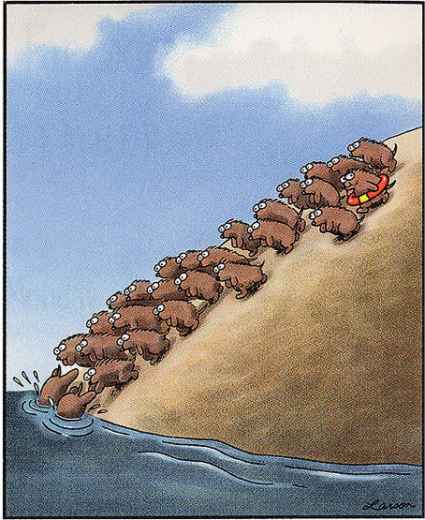Even among people who accept that evolution occurs and feel they have a decent understanding of it, the finer details of how evolution occurs are still fairly tricky. I've tried to synthesize primary literature and popular press articles here to help explain some confusion.
1. “Evolution means organisms are becoming better.”
Evolution is just a change in the frequencies of characteristics in a population. Natural selection (one way through which evolution can occur) means these changes are in response to the environment. The environment can change, however, and what was advantageous last year might not be so this year. In great tits, the size of beech crop that spring (the number of beech seeds) can select for either thorough or superficial explorers, for example, though the size of the crop varies every year.
Also, a species can just as easily evolve towards decreased complexity. Many cave-dwelling species have lost eyes and pigmentation because the energy required to develop and maintain those features isn’t worth it when they’re not being used. Similarly, while humans have highly developed respiratory, circulatory, and digestive systems relative to ants, ants compose 15-20% of the Earth's terrestrial biomass and do quite fine without all that extra morphological complexity.
2. “Evolution is for the betterment of the species.”
While group selection is a topic of hot debate among evolutionary biologists, the discussion concerns details separate from this misconception (e.g. why honeybees will continue to serve their hive if they can’t reproduce and pass on their own genes). A common example of the “betterment of the species” misunderstanding is of lemmings drowning themselves to prevent overpopulation. The idea is that when density gets too high and there just aren’t enough resources to go around, some of the lemmings should off themselves to prevent the collapse of the whole group. While this sounds tempting, the problem is that it would never evolve.
 This comic by Gary Larson actually illustrates the point perfectly: if just one individual can cheat the system (i.e. not kill itself), the cheater can reproduce and pass on its ‘cheater’ alleles to the next generation. Hence, the mass suicide would be undermined. If anything, this would be extremely fast selection against doing something that altruistic, because anyone that had the alleles to do that wouldn’t survive to pass them on.
This comic by Gary Larson actually illustrates the point perfectly: if just one individual can cheat the system (i.e. not kill itself), the cheater can reproduce and pass on its ‘cheater’ alleles to the next generation. Hence, the mass suicide would be undermined. If anything, this would be extremely fast selection against doing something that altruistic, because anyone that had the alleles to do that wouldn’t survive to pass them on. Another way of addressing this misconception is reiterating that evolution does not have a ‘goal.’ Organisms do not become perfectly adapted to their environments, and they’re not proceeding towards some end point of higher consciousness or complexity. Consider the horseshoe crab, which has stayed relatively the same for 150-200 million years.
3. “Humans are not currently evolving.”
While we may have greatly diminished the effects of natural selection due to technological and medical advances, we are still undergoing mutation, gene flow, and small levels of genetic drift. The pressures we faced in our hunter-gatherer days are quite different from today, now that we live in much higher densities and have entirely different diets. The gene for the enzyme lactase, which digests the sugar lactose in milk, for example, evolved and spread through European populations merely ~7,000 years ago. Another recent development is human resistance to malaria.
4. “Humans are more evolved than other species.”
If the common ancestor hypothesis is correct, and more life didn’t come crashing onto Earth via an asteroid or something, all species on Earth today have undergone the same amount of evolutionary time. While humans may possess higher cognitive ability than other species, this has nothing to do with how much evolution has occurred. Even relatively-unchanged species like the aforementioned horseshoe crab have been evolving this entire time, albeit through more of an internal "fine tuning" than a rearranging of body plan.
5. “Humans cannot influence evolution.”
This idea overlooks how humans have selected for dog breeds, crop output, and antibiotic resistance in bacteria, HIV, malaria, and cancer. Humans have long knowingly and unknowingly selected for favorable traits in the crops that give us our food or for the animals we keep as pets. Outside of direct human-organism interaction, climate change has changed the breeding and migration of several species and the appearance of cities has selected for behavioral and morphological traits of animals living there. As we change our environment, we inevitably change the animals, plants, and microbes within it as well. The direction of that change, towards extinction or successful coexistence, is up to us.
This list is not exhaustive. I found ideas for which misconceptions to address from the following sources:
- Wikipedia: "List of common misconceptions - evolution"
- UC Berkeley's "Understanding evolution"
- Talk Origins: "Five Major Misconceptions about Evolution"
No comments:
Post a Comment